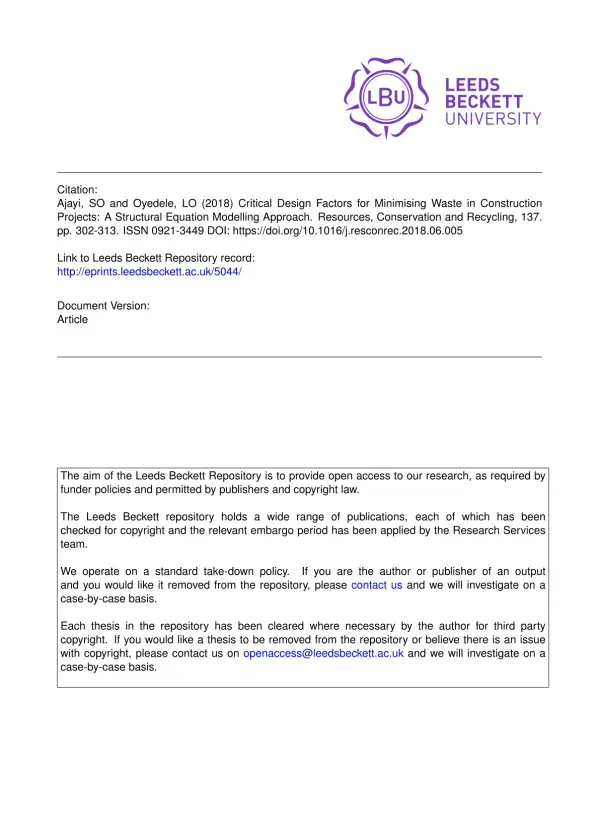
Minimising Waste in Construction Projects through Effective Design Strategies
Document information
| Author | Ajayi, S. O. |
| School | Leeds Beckett University |
| Year of publication | 2018 |
| Place | Leeds |
| Document type | article |
| Language | English |
| Number of pages | 34 |
| Format | |
| Size | 1.42 MB |
- Construction Waste Management
- Design for Sustainability
- Structural Equation Modelling
Summary
I. Introduction to Waste in Construction
The construction industry is a significant contributor to waste generation, with estimates indicating that 44% of total waste in the UK is attributed to construction and demolition activities. This figure starkly contrasts with waste contributions from other sectors, such as commercial and household waste, which account for 14% and 13%, respectively. The implications of such waste generation extend beyond mere statistics; they encompass environmental degradation and economic inefficiencies. The significance of addressing waste in construction is underscored by the potential for substantial cost savings. For instance, a study by the UK’s Building Research Establishment suggests that reducing construction waste by just 5% could yield savings of up to £130 million. This highlights the urgent need for effective waste management strategies that prioritize waste minimization from the design phase onward.
1.1. Environmental and Economic Impacts
The environmental impacts of construction waste are profound, contributing to pollution and the depletion of landfill sites. Waste materials can leach harmful substances into the soil and water, posing risks to ecosystems and human health. Economically, the costs associated with waste management, including disposal fees and material losses, are often transferred to clients, inflating project costs. The EU Waste Framework Directive aims to mitigate these issues by setting ambitious targets for waste reduction and recycling. Such legislative measures reflect a growing recognition of the need for sustainable practices within the construction sector.
II. Design Strategies for Waste Minimization
Effective design strategies play a crucial role in minimizing waste in construction projects. The study emphasizes the importance of designing for standard material sizes and adopting modern methods of construction. These approaches can significantly reduce waste caused by breakage and leftover materials. Furthermore, the design process itself, along with comprehensive design documentation, is identified as a key factor in waste mitigation. A collaborative delivery process, characterized by early contractor involvement and interdisciplinary coordination, enhances the effectiveness of these strategies. By integrating waste minimization into the design phase, stakeholders can achieve a more sustainable construction process.
2.1. Collaborative Design Approaches
Collaboration among various stakeholders is essential for successful waste minimization. Engaging contractors early in the design process allows for better alignment of project goals and resource management. The study highlights that a collaborative design approach not only fosters innovation but also ensures that all parties are aware of waste reduction objectives. This proactive engagement can lead to more efficient use of materials and a reduction in overall project waste, ultimately contributing to a more sustainable construction industry.
III. Conclusion and Practical Applications
The findings of this study underscore the critical need for a paradigm shift in how waste management is approached within the construction industry. By prioritizing design strategies that focus on waste minimization, significant environmental and economic benefits can be realized. The integration of design out waste principles into the construction process not only enhances project outcomes but also aligns with broader sustainability goals. As the industry continues to evolve, the adoption of these strategies will be vital in addressing the challenges posed by construction waste and achieving a more sustainable future.
3.1. Future Directions
Future research should focus on developing more comprehensive frameworks for implementing waste minimization strategies across all stages of construction projects. This includes exploring the role of technology in facilitating better design practices and enhancing collaboration among stakeholders. By fostering a culture of sustainability within the construction sector, the potential for reducing waste and improving project efficiency can be significantly enhanced.
Document reference
- Critical Design Factors for Minimising Waste in Construction Projects: A Structural Equation Modelling Approach (Ajayi, SO and Oyedele, LO)
- Construction and Demolition Waste: A Review of the Literature (Yu, A., et al.)
- Construction Waste Management: A Review of the Literature (Yeheyis, M., et al.)
- Construction Waste Minimisation: A Review of the Literature (Lu, W. and Tam, V.)
- Waste Minimisation in Construction: A Review of the Literature (Osmani, M., et al.)
